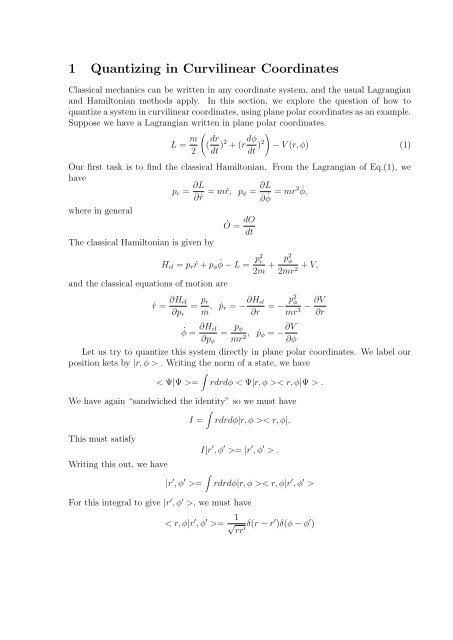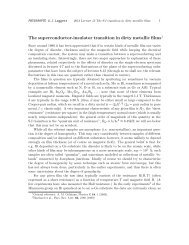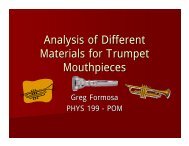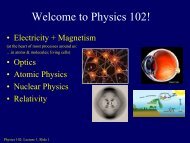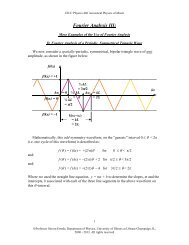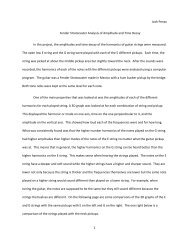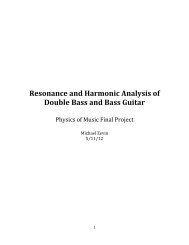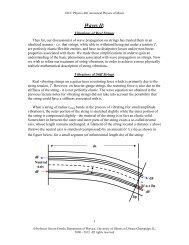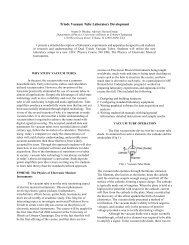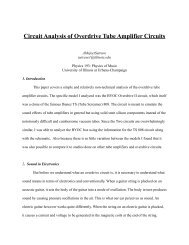1 Quantizing in Curvilinear Coordinates
1 Quantizing in Curvilinear Coordinates
1 Quantizing in Curvilinear Coordinates
Create successful ePaper yourself
Turn your PDF publications into a flip-book with our unique Google optimized e-Paper software.
1 <strong>Quantiz<strong>in</strong>g</strong> <strong>in</strong> Curvil<strong>in</strong>ear Coord<strong>in</strong>ates<br />
Classical mechanics can be written <strong>in</strong> any coord<strong>in</strong>ate system, and the usual Lagrangian<br />
and Hamiltonian methods apply. In this section, we explore the question of how to<br />
quantize a system <strong>in</strong> curvil<strong>in</strong>ear coord<strong>in</strong>ates, us<strong>in</strong>g plane polar coord<strong>in</strong>ates as an example.<br />
Suppose we have a Lagrangian written <strong>in</strong> plane polar coord<strong>in</strong>ates.<br />
L = m<br />
(<br />
(<br />
2<br />
dr<br />
dt )2 + (r dϕ<br />
dt )2<br />
)<br />
− V (r, ϕ) (1)<br />
Our first task is to f<strong>in</strong>d the classical Hamiltonian. From the Lagrangian of Eq.(1), we<br />
have<br />
pr = ∂L<br />
∂ ˙r = m ˙r, pϕ = ∂L<br />
∂ ˙ ϕ = mr2ϕ, ˙<br />
where <strong>in</strong> general<br />
The classical Hamiltonian is given by<br />
˙O = dO<br />
dt<br />
Hcl = pr ˙r + pϕ ˙ ϕ − L = p2r 2m + p2ϕ + V,<br />
2mr2 and the classical equations of motion are<br />
˙r = ∂Hcl<br />
∂pr<br />
= pr<br />
m , ˙pr = − ∂Hcl<br />
∂r = − p2ϕ ∂V<br />
−<br />
mr3 ∂r<br />
˙ϕ = ∂Hcl<br />
∂pϕ<br />
= pϕ<br />
mr2 , ˙pϕ = − ∂V<br />
∂ϕ<br />
Let us try to quantize this system directly <strong>in</strong> plane polar coord<strong>in</strong>ates. We label our<br />
position kets by |r, ϕ > . Writ<strong>in</strong>g the norm of a state, we have<br />
∫<br />
< Ψ|Ψ >= rdrdϕ < Ψ|r, ϕ >< r, ϕ|Ψ > .<br />
We have aga<strong>in</strong> “sandwiched the identity” so we must have<br />
∫<br />
I = rdrdϕ|r, ϕ >< r, ϕ|.<br />
This must satisfy<br />
Writ<strong>in</strong>g this out, we have<br />
I|r ′ , ϕ ′ >= |r ′ , ϕ ′ > .<br />
|r ′ , ϕ ′ ∫<br />
>= rdrdϕ|r, ϕ >< r, ϕ|r ′ , ϕ ′ ><br />
For this <strong>in</strong>tegral to give |r ′ , ϕ ′ >, we must have<br />
< r, ϕ|r ′ , ϕ ′ >= 1<br />
√ rr ′ δ(r − r′ )δ(ϕ − ϕ ′ )
Operators We expect there to be operators R, Pr, Φ, Pϕ. If we follow the procedure<br />
used <strong>in</strong> Cartesian coord<strong>in</strong>ates, we would write commutation rules,<br />
These are satisfied if<br />
and<br />
[R, Pr] = i¯h, [Φ, Pϕ] = i¯h<br />
< r, ϕ|Pr|Ψ >= ¯h ∂<br />
< r, ϕ|Ψ >,<br />
i ∂r<br />
< r, ϕ|Pϕ|Ψ >= ¯h ∂<br />
< r, ϕ|Ψ >,<br />
i ∂ϕ<br />
We may now ask if Pr and Pϕ def<strong>in</strong>ed this way are self-adjo<strong>in</strong>t. It will turn out that Pϕ<br />
is self-adjo<strong>in</strong>t but Pr is not. Let us consider Pϕ first. If Pϕ is self-adjo<strong>in</strong>t, we must have<br />
< Ψ2|PϕΨ1 >=< PϕΨ2|Ψ1 ><br />
Def<strong>in</strong><strong>in</strong>g the right hand side as (a), and the left hand side as (b), we have<br />
and (b) is<br />
∫<br />
(a) =<br />
∫<br />
(b) =<br />
Ψ ∗ 2(r, ϕ)( ¯h<br />
i<br />
( ¯h<br />
i<br />
∂<br />
∂ϕ Ψ1(r, ϕ))rdrdϕ,<br />
∂<br />
∂ϕ Ψ2(r, ϕ)) ∗ Ψ1(r, ϕ)rdrdϕ<br />
Show<strong>in</strong>g that (a) = (b) is a simple exercise <strong>in</strong> <strong>in</strong>tegration by parts on ϕ, us<strong>in</strong>g the physical<br />
requirement that wave functions must be periodic, i.e. Ψ(r, 0) = Ψ(r, 2π). So we have<br />
that<br />
Pϕ = (Pϕ) † ,<br />
so quantiz<strong>in</strong>g naively was f<strong>in</strong>e for Pϕ.<br />
Let us turn to ask<strong>in</strong>g the same question for Pr. If Pr is self-adjo<strong>in</strong>t, we will have<br />
< Ψ2|PrΨ1 >=< PrΨ2|Ψ1 ><br />
Aga<strong>in</strong> writ<strong>in</strong>g left and right hand sides out, we def<strong>in</strong>e<br />
∫<br />
(a) =< Ψ2|PrΨ1 >=<br />
Ψ ∗ 2(r, ϕ)( ¯h<br />
i<br />
∂<br />
∂r Ψ1(r, ϕ))rdrdϕ,<br />
and<br />
∫<br />
(b) =< PrΨ2|Ψ1 >= ( ¯h ∂<br />
i ∂r Ψ2(r, ϕ)) ∗ Ψ1(r, ϕ)rdrdϕ<br />
We can get the relation between (a) and (b) by <strong>in</strong>tegration by parts <strong>in</strong> r. Do<strong>in</strong>g so on<br />
(a), we have<br />
∫<br />
(a) = ( ¯h ∂<br />
i ∂r rΨ2(r, ϕ)) ∗ Ψ1(r, ϕ)drdϕ
(The surface terms <strong>in</strong> the <strong>in</strong>tegration by parts vanish because rΨr(r, ϕ)Ψ1(r, ϕ) vanishes<br />
at both r = 0 and r = ∞.) Our expression after <strong>in</strong>tegration by parts is<br />
∫<br />
(a) = ( ¯h ∂<br />
i ∂r Ψ2(r, ϕ)) ∗ ∫<br />
Ψ1(r, ϕ)rdrdϕ + ( ¯h<br />
i Ψ2(r, ϕ)) ∗ Ψ1(r, ϕ)drdϕ<br />
∫<br />
=< PrΨ2|Ψ1 > + ( ¯h<br />
i Ψ2(r, ϕ)) ∗ Ψ1(r, ϕ)drdϕ.<br />
The presence of the extra <strong>in</strong>tegral term on the right hand side of the last equation means<br />
that Pr is not self-adjo<strong>in</strong>t. The problem is of course that the <strong>in</strong>tegration weight rdrdϕ<br />
depends on r.<br />
Modified Radial Momentum It turns out to be possible to modify Pr so the<br />
result is self-adjo<strong>in</strong>t. We def<strong>in</strong>e a new radial momentum operator by<br />
This operator satisfies<br />
< r, ϕ| ˜ Pr|Ψ >≡ ¯h ∂ 1<br />
( + ) < r, ϕ|Ψ ><br />
i ∂r 2r<br />
˜Pr = ( ˜ Pr) † .<br />
We may now try to construct a quantum Hamiltonian by us<strong>in</strong>g ˜ Pr. This would give<br />
˜H = ˜ P 2 r<br />
2m + P 2 ϕ<br />
+ V<br />
2mr2 Us<strong>in</strong>g this as on a wave function we would get<br />
< r, ϕ| ˜ {<br />
H|Ψ >= − ¯h2<br />
[<br />
(<br />
2m<br />
∂ 1 ∂ 1 1<br />
+ )( + ) +<br />
∂r 2r ∂r 2r r2 ∂2 ∂ϕ2 ] }<br />
+ V < r, ϕ|Ψ ><br />
Work<strong>in</strong>g out the derivatives <strong>in</strong> terms of the Laplacian, we have<br />
< r, ϕ| ˜ {<br />
H|Ψ >= − ¯h2<br />
}<br />
¯h2<br />
∆ + + V < r, ϕ|Ψ >,<br />
2m 4mr2 where the Laplacian is the usual plane polar expression,<br />
∆ = 1<br />
r<br />
∂ ∂ 1<br />
(r ) +<br />
∂r ∂r r2 Our modified Hamiltonian has produced a sensible result, <strong>in</strong>volv<strong>in</strong>g an extra term<br />
O(¯h 2 ) that must be added to the orig<strong>in</strong>al potential. The fact that this extra term is<br />
O(¯h 2 ) means that it would disappear on go<strong>in</strong>g to the classical limit. However we can<br />
argue aga<strong>in</strong>st <strong>in</strong>clud<strong>in</strong>g this term by consider<strong>in</strong>g a free particle with V = 0. Here we<br />
surely believe that the wave function can be built up out of plane waves, where<br />
∂ 2<br />
∂ϕ 2<br />
< ⃗x|⃗p >= 1 · ⃗x<br />
exp(i⃗p<br />
2π¯h ¯h ),
and all vectors are two-dimensional. For these plane waves the correct quantum Hamiltonian<br />
is (still free particle)<br />
< r, ϕ|H|Ψ >= − ¯h2<br />
∆ < r, ϕ|Ψ > .<br />
2m<br />
Here we can certa<strong>in</strong>ly rule out the term ¯h 2 /4mr 2 . Go<strong>in</strong>g back to the presence of a potential,<br />
if the extra term is ruled out for a free particle, it should also be ruled out when<br />
a potential is present.<br />
Summary While it may be possible to construct momentum operators <strong>in</strong> curvil<strong>in</strong>ear<br />
coord<strong>in</strong>ates which are self-adjo<strong>in</strong>t, the correct procedure is to use the Laplacian as the<br />
k<strong>in</strong>etic energy term <strong>in</strong> the Schröd<strong>in</strong>ger equation, and not try to express the k<strong>in</strong>etic energy<br />
as sums of squares of the modified momentum operators.<br />
So for plane polar coord<strong>in</strong>ates, if the classical Hamiltonian is<br />
Hc = 1<br />
2m p2 r + 1<br />
2mr 2 p2 ϕ + V,<br />
The correct quantum Hamiltonian is def<strong>in</strong>ed by<br />
where<br />
< r, ϕ|H|Ψ >=<br />
∆ = 1<br />
r<br />
{<br />
− ¯h2<br />
∆ + V<br />
2m<br />
∂ ∂ 1<br />
r +<br />
∂r ∂r r2 }<br />
∂2 .<br />
∂ϕ2 < r, ϕ|Ψ >,<br />
Likewise, <strong>in</strong> spherical coord<strong>in</strong>ates, the classical Hamiltonian will be of the form<br />
The quantum Hamiltonian is def<strong>in</strong>ed by<br />
Hc = 1<br />
2m p2r + 1<br />
2mr2 p2 1<br />
θ +<br />
2mr2 s<strong>in</strong>2 θ p2ϕ + V.<br />
< r, θ, ϕ|H|Ψ >=<br />
{<br />
− ¯h2<br />
∆ + V<br />
2m<br />
where ∆ is the usual Laplacian <strong>in</strong> spherical coord<strong>in</strong>ates,<br />
∆ = 1<br />
r 2<br />
∂ ∂ 1<br />
r2 +<br />
∂r ∂r r2 and <strong>in</strong> spherical coord<strong>in</strong>ates, we have<br />
1<br />
s<strong>in</strong> θ<br />
< r, θ, ϕ|r ′ , θ ′ , ϕ ′ >= δ(r − r′ )<br />
rr ′<br />
}<br />
∂ ∂ 1<br />
s<strong>in</strong> θ +<br />
∂θ ∂θ r2 < r, θ, ϕ|Ψ >,<br />
1<br />
s<strong>in</strong> 2 θ<br />
∂2 ,<br />
∂ϕ2 δ(θ − θ ′ )<br />
√<br />
s<strong>in</strong> θ s<strong>in</strong> θ ′ δ(ϕ − ϕ′ ).


